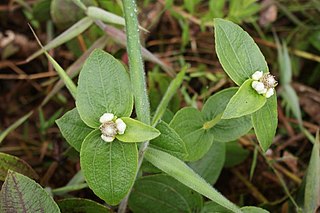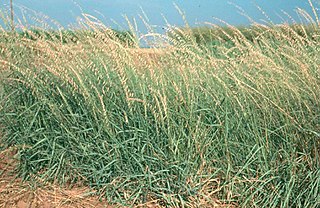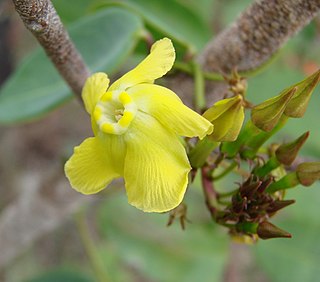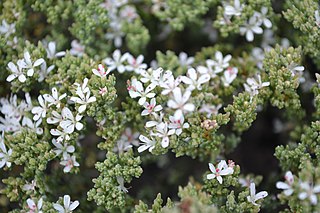
Ichthyothere is a genus of flowering plants, found in parts of South America and Central America.

Lantana is a genus of about 150 species of perennial flowering plants in the verbena family, Verbenaceae. They are native to tropical regions of the Americas and Africa but exist as an introduced species in numerous areas, especially in the Australian-Pacific region, South and Northeastern part of India. The genus includes both herbaceous plants and shrubs growing to 0.5–2 m (1.6–6.6 ft) tall. Their common names are shrub verbenas or lantanas. The generic name originated in Late Latin, where it refers to the unrelated Viburnum lantana.

Calliandra is a genus of flowering plants in the pea family, Fabaceae, in the mimosoid clade of the subfamily Caesalpinioideae. It contains about 140 species that are native to tropical and subtropical regions of the Americas.

Persoonia, commonly known as geebungs or snottygobbles, is a genus of about one hundred species of flowering plants in the family Proteaceae. Plants in the genus Persoonia are shrubs or small trees usually with smooth bark, simple leaves and usually yellow flowers arranged along a raceme, each flower with a leaf or scale leaf at the base. The fruit is a drupe.

Alonsoa is a genus of 12 species of flowering plants in the family Scrophulariaceae. The genus includes both herbaceous and shrubby species.

Bouteloua is a genus of plants in the grass family Poaceae. Members of the genus are commonly known as grama grass.

Jungia is a genus of flowering plants in the family Asteraceae. It is native mostly to South America, with one widespread species extending its range into Central America and southern Mexico.

Rinorea is a genus of flowering plants in family Violaceae. It includes 212 species native to the subtropics and tropics.

Utricularia arenaria is a small annual carnivorous plant that belongs to the genus Utricularia. It is native to tropical and southern Africa, where it can be found in Angola, Burundi, Cameroon, Côte d'Ivoire, the Democratic Republic of the Congo, Ethiopia, Gabon, Ghana, Kenya, Madagascar, Malawi, Mali, Mozambique, Nigeria, Senegal, Sierra Leone, South Africa, Sudan, Tanzania, Togo, Uganda, Zambia, and Zimbabwe. There has also been a single collection from central India in Madhya Pradesh. U. arenaria grows as a terrestrial plant in damp, sandy or peaty soils in swampy grasslands or marshes at altitudes from near sea level to 2,400 m (7,874 ft). It was originally described and published by Alphonse Pyrame de Candolle in 1844.

Prestonia is a genus of plants in the family Apocynaceae, first described as a genus in 1810. It is native to Mexico, Central America, South America, and the West Indies. It is closely related to Artia and Parsonsia.

Chromolaena is a genus of about 165 species of perennials and shrubs in the family Asteraceae. The name is derived from the Greek words χρῶμα (khrôma), meaning "color", and χλαῑνα (khlaīna) or λαῑνα (laīna) meaning "cloak". It refers to the colored phyllaries of some species. Members of the genus are native to the Americas, from the southern United States to South America. One species, Chromolaena odorata, has been introduced to many parts of the world where it is considered a weed.

Lumnitzera is an Indo-West Pacific mangrove genus in the family Combretaceae. An English common name is black mangrove. Lumnitzera, named after the German botanist, Stephan Lumnitzer (1750-1806), occurs in mangroves from East Africa to the Western Pacific, and northern Australia.

Frankenia is the only genus in the Frankeniaceae family of flowering plants. Other genera have been recognized within the family, such as Anthobryum, Hypericopsis and Niederleinia, but molecular phylogenetic studies have consistently shown that they all belong inside Frankenia. Frankenia comprises about 70–80 species of shrubs, subshrubs and herbaceous plants, adapted to saline and dry environments throughout temperate and subtropical regions. A few species are in cultivation as ornamental plants.
Diosma is a genus of flowering plants in the family Rutaceae, native to Cape Provinces of South Africa. The genus was first described by Carl Linnaeus in 1753.

Nelsonia is a genus of plants in the family Acanthaceae. They can be found in tropical: Africa, Latin America, south-east Asia and Australia.

Commicarpus is a genus of flowering plants belonging to the family Nyctaginaceae. The genus contain some 30 to 35 species which are native to the tropics and subtropics. Most are found in Africa and western Asia, and eight species are native to southern Africa.

Fuirena, called umbrella sedges or umbrella grasses, are a genus of flowering plants in the sedge family (Cyperaceae), with a worldwide distribution, chiefly in the tropics and temperate zones. They are named for Danish physician and early botanist Georg Fuiren, 1581–1628.
















